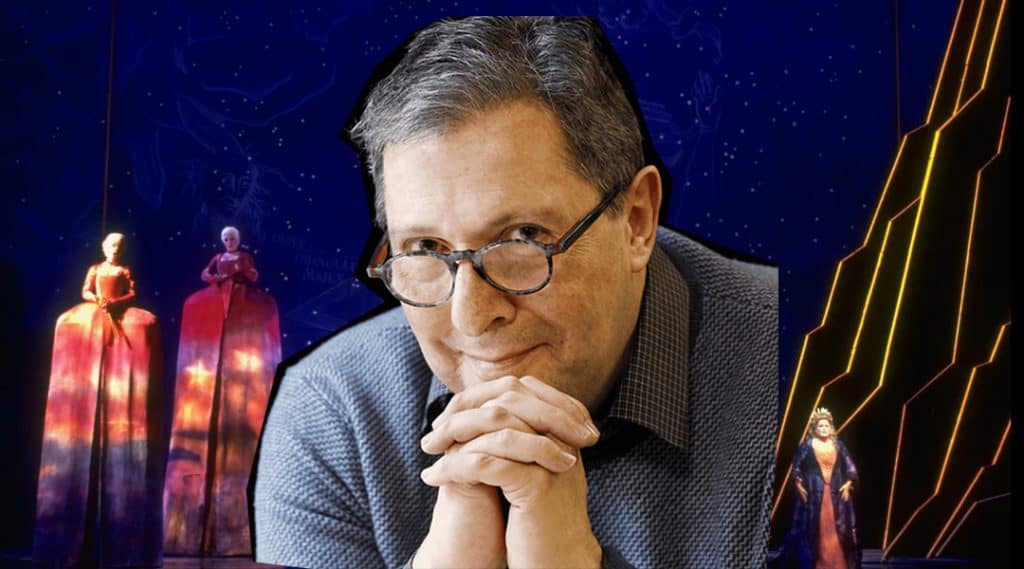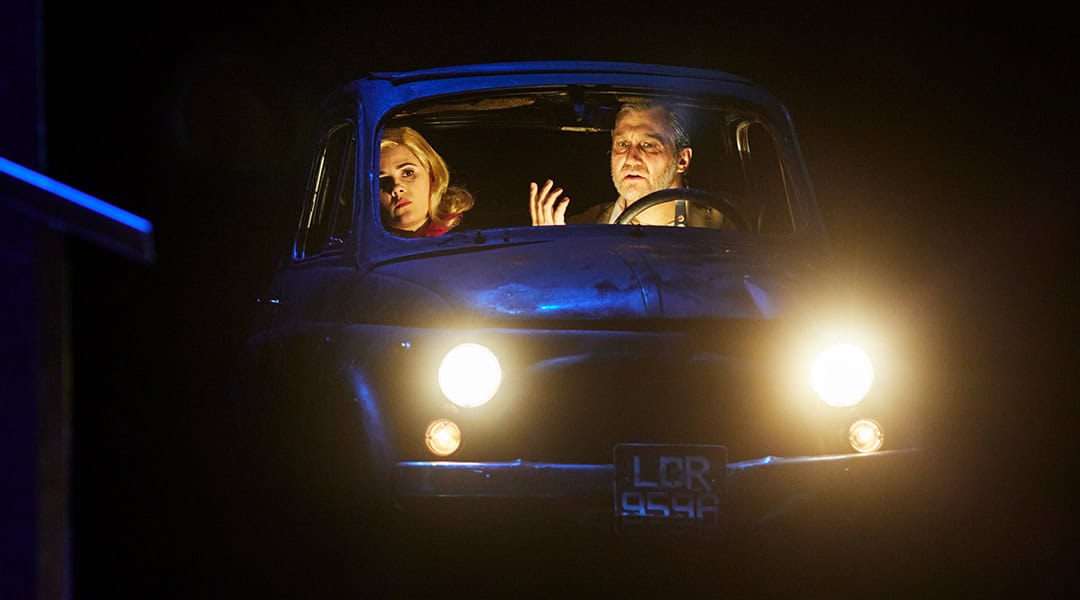
Elijah Moshinsky, in front of an image of his Ariadne auf Naxos for the Metropolitan Opera. Headshot courtesy of Opera Australia.
Welcome back to Stage Notes, the series where we take you inside and behind the scenes of our fantastic mainstage opera productions, sharing fresh insight into the worlds built on our stages.
For this second instalment for our Rigoletto season, and with opening night just one more sleep away, we wanted to share some backstory for its iconic staging – a work by a modern master, which has graced theatres worldwide for more than three decades
“Directness, Clarity, Truth and Simplicity”
In an obituary published by The Guardian after his passing in 2021, noted classical music scholar and critic Barry Millington spoke of Elijah Moshinsky as a director who leaned notably away from the deconstruction and irony so often present in the work of his contemporaries. Moshinsky himself made his thoughts on the subject particularly clear in a 1992 article for Opera magazine titled ‘Verdi: a pox on postmodernism’, wherein he offered a reasonably firm rebuke to what he termed the “critical orthodoxy” he perceived as dominating the artform through the late 20th century.
But while Moshinsky’s words caused quite a stir at the time, the point he was making was a reasonably straightforward one: while he was conscious of the folly of pursuing absolute fidelity to traditional presentations of opera, he also felt strongly that modern directors should avoid diluting the power of the work as written by acquiescing too easily to notions of “political correctness”. His iconic Rigoletto, premiered the year prior, served as a great illustration not only of this philosophy, but of the formidable scale of his directorial deftness.
A Taste of La Dolce Vita
Even among his vanguardist mid-20th-century contemporaries, Federico Fellini is a film director whose reputation sets him well apart from his cohort – his 1963 masterpiece 81⁄2 in particular is still widely considered one of the finest films ever made. It was Fellini’s earlier La Dolce Vita, however, which delivered the most explicit inspiration for the on-stage world of Moshinsky’s Rigoletto – the “decadence, squalor, beauty and ugliness” held within Fellini’s depiction of a hedonistic, opportunistic post-war Rome transposed onto the anti-monarchist parable of Verdi and Piave’s original work.
As the staging’s more-than-30-year performance history would suggest, Moshinsky’s choice was an inspired one. Even today the production has lost none of its power, immersing and transporting its audience from its very first bars. As the curtain rises and the lights come up on the Duke’s imposing, opulent palace, you’ll be in no doubt of the world being occupied – and when the hulking, six-ton set revolves to reveal Rigoletto’s considerably more humble home, the effect is even more pronounced; the callous schemes and machinations of the opera’s characters making all the more sense against a backdrop that emphasises the deep chasm between its haves and have-nots.
But although the broad strokes beautifully establish the setting, it’s in the finer detail where Moshinsky’s vision truly shines. Every aspect of the opera’s various tableaux has been carefully considered for time-and-place fidelity, from its meticulously selected props and costumes to maybe its most iconic piece of stage dressing: Rigoletto’s own Fiat 500, scene-stealing in its own right and the setting for one of the opera’s most emotional moments.

The iconic Fiat 500 (photo: Keith Saunders for Opera Australia)
Bringing Moshinsky’s Rigoletto (back) to life
Of course, performing such a distinctive work – and especially one seen as so definitive in its original director’s body of work – is no mean feat. Writing for our programme notes, revival director Shane Placentino – who also helmed Opera Australia’s 2023 season of Rigoletto – describes himself as a ‘custodian’ for this production; charged with preserving Moshinsky’s vision, but also with breathing new life into the work. To that end, he spotlights the considerable efforts of his whole cast in supporting that work:
“Everyone involved has a responsibility as a flame keeper. James Clayton as Rigoletto, Elena Perroni as Gilda, and Amitai Pati as the Duke each have their own personal connection to this opera, making it interesting, invigorating, and inspiring to blend these ideas together. Sian Sharp as Giovanna and Maddelena, along with Jud Arthur as her brother Sparafucile, form a formidable and experienced combination.
Observing Taylor Wallbank as Borsa, Joel Amosa as Marullo, and Alfred Fonoti-Fuimaono as Count Ceprano as they develop their characters individually and as a group is encouraging for the future of singers from this part of the world. The pathos shown by James Harrison as Monterone is heartfelt and leads to a compelling drive for revenge. Sarah Mileham as the thwarted Countess Ceprano, Te Ohorere Williams as the astute Page, and Ipu Laga’aia as the formal Usher all highlight the opera’s depth. The New Zealand Opera Chorus has provided the energy required to make this iteration extremely powerful.”
For Placentino, the clarity and power of this season will come from the way that the work’s history – “the collaboration of Giuseppe Verdi, Francesco Piave, and – across eras – Elijah Moshinsky” – will be reanimated within the walls of the Kiri Te Kanawa Theatre.
And for our director, that’s also where he finds joy in the process: “We’ve all come together and created our own version of this opera, if you like. The artistry that comes out, and what we can create using Rigoletto as our vehicle…that’s the best part of my job.”
